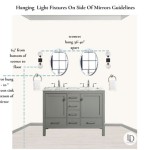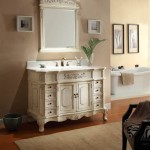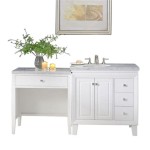Wooden Vessel Bathroom Sinks: Aesthetics, Practicality, and Considerations
Wooden vessel bathroom sinks are rapidly gaining popularity as homeowners and designers seek to infuse natural elements and unique aesthetics into bathroom spaces. These sinks offer a departure from traditional ceramic or stone options, providing a warm, organic feel that can transform a bathroom's ambiance. This article explores the various aspects of wooden vessel bathroom sinks, including their inherent advantages, potential drawbacks, material choices, installation considerations, maintenance requirements, and overall suitability for different bathroom designs.
Aesthetic Appeal and Design Versatility
The primary draw of wooden vessel sinks lies in their aesthetic appeal. Wood inherently possesses a warmth and texture that is difficult to replicate with synthetic materials. This natural beauty can lend a sense of serenity and sophistication to a bathroom, creating a spa-like atmosphere. The grain patterns, variations in color, and unique imperfections in the wood add character and individuality to each sink, ensuring that no two are exactly alike. This uniqueness is particularly appealing to those seeking a personalized and distinctive bathroom design.
Furthermore, wooden vessel sinks offer considerable design versatility. They can be incorporated into a wide range of bathroom styles, from rustic and farmhouse to modern and minimalist. The type of wood used, the shape of the sink, and the finish applied all contribute to its overall aesthetic. For instance, a sink crafted from reclaimed wood with a natural oil finish might be ideal for a rustic bathroom, while a sleek, dark-stained sink made from a hardwood like walnut could complement a contemporary design. The ability to customize the wood type, shape, and finish allows designers to seamlessly integrate wooden vessel sinks into various aesthetic schemes.
The visual impact of a wooden vessel sink can be further enhanced by the choice of accompanying fixtures and accessories. Matte black faucets and hardware, for example, can create a striking contrast against the warm tones of the wood. Similarly, natural stone countertops and backsplashes can complement the organic feel of the sink, creating a cohesive and harmonious bathroom design. The possibilities for creating visually stunning and personalized bathroom spaces with wooden vessel sinks are virtually limitless.
Material Selection and Durability Considerations
The durability and longevity of a wooden vessel sink are heavily influenced by the type of wood used in its construction. Certain wood species are naturally more resistant to moisture, decay, and warping, making them better suited for bathroom applications. Hardwoods, such as teak, walnut, and mahogany, are generally preferred due to their density, inherent oil content, and resistance to water damage. These woods are also less prone to cracking and splitting, ensuring that the sink maintains its structural integrity over time. Softwoods, such as pine and cedar, can also be used, but they typically require more extensive treatment and sealing to protect them from moisture-related issues.
In addition to the type of wood, the construction method also plays a crucial role in the sink's durability. Solid wood construction, where the sink is carved from a single piece of wood, is generally considered the most durable option. However, this method can be more expensive and may be prone to cracking if the wood is not properly dried and seasoned. Alternatively, laminated wood construction, where multiple layers of wood are glued together, can provide greater stability and resistance to warping. The quality of the adhesive used in laminated construction is critical, as it must be waterproof and capable of withstanding prolonged exposure to moisture.
The finish applied to the wooden sink is also essential for protecting it from water damage and maintaining its appearance. Waterproof sealants, such as marine-grade varnish, epoxy resin, or specialized wood oils, are commonly used to create a barrier against moisture penetration. These finishes not only protect the wood from water damage but also enhance its natural beauty and provide a smooth, easy-to-clean surface. Regular reapplication of the sealant may be necessary to maintain the sink's protective properties and prevent water damage over time.
Installation and Plumbing Considerations
Installing a wooden vessel sink requires careful planning and attention to detail. Unlike traditional drop-in sinks, vessel sinks sit on top of the countertop, which can affect the overall height of the vanity and the ease of use. It is important to consider the height of the sink in relation to the user's height to ensure that the finished installation is comfortable and ergonomically sound. The countertop will need a hole drilled for the drain, and the faucet will typically be mounted either on the countertop or on the wall behind the sink.
Plumbing considerations are also critical when installing a wooden vessel sink. The drain assembly must be compatible with the sink's drain hole and the existing plumbing system. A pop-up drain or a grid drain is commonly used with vessel sinks, and the drain tailpiece must be properly connected to the P-trap to prevent sewer gases from entering the bathroom. The faucet selection should also be carefully considered, as the spout height and reach must be appropriate for the vessel sink to avoid splashing and ensure comfortable use. Tall, vessel-specific faucets are often required to reach over the height of the sink.
Proper sealing is essential to prevent water damage around the base of the sink and where the drain assembly connects to the sink. A bead of silicone sealant should be applied to the base of the sink before it is placed on the countertop, and the drain assembly should be properly sealed to prevent leaks. Regular inspection of these seals is recommended to ensure that they remain intact and prevent water from seeping into the surrounding areas. Professional installation is highly recommended, especially for those unfamiliar with plumbing procedures.
Maintenance and Care
Maintaining a wooden vessel sink requires a different approach compared to traditional ceramic or stone sinks. Wood is a natural material that is susceptible to damage from prolonged exposure to water and harsh chemicals. Regular cleaning with a soft cloth and mild soap is generally sufficient to keep the sink clean and free of stains. Abrasive cleaners, scouring pads, and harsh chemicals should be avoided, as they can scratch the finish and damage the wood. After each use, the sink should be wiped dry to prevent water from pooling and potentially causing water spots or discoloration.
Periodic maintenance, such as re-oiling or re-sealing the wood, may be necessary to maintain its protective properties and prevent water damage. The frequency of this maintenance will depend on the type of wood, the finish applied, and the frequency of use. Signs of water damage, such as discoloration, warping, or cracking, should be addressed promptly to prevent further deterioration. Small scratches or imperfections can often be repaired with wood filler or touch-up paint, while more serious damage may require professional repair or refinishing.
The environment in which the sink is located can also affect its longevity. High humidity levels can accelerate the rate of water absorption, while extreme temperature fluctuations can cause the wood to expand and contract, potentially leading to cracking. Proper ventilation in the bathroom can help to reduce humidity levels, and avoiding drastic temperature changes can help to prolong the life of the sink. Regular inspection and maintenance are key to ensuring that a wooden vessel sink remains beautiful and functional for years to come.
Suitability and Considerations for Different Bathroom Styles
Wooden vessel sinks are not universally suitable for all bathroom styles and lifestyles. Their susceptibility to water damage and the need for regular maintenance may make them a less practical choice for high-traffic bathrooms or households with young children who may be less careful. However, for those who appreciate the natural beauty of wood and are willing to invest the time and effort required to maintain it, a wooden vessel sink can be a stunning addition to any bathroom.
Consideration should be given to the overall design aesthetic of the bathroom when selecting a wooden vessel sink. A rustic or farmhouse-style bathroom can benefit from the warmth and texture of a natural wood sink, while a modern or minimalist bathroom may require a sleek, dark-stained sink to complement the clean lines and contemporary aesthetic. The size and shape of the sink should also be appropriate for the available space and the intended use. A small, round sink may be suitable for a powder room, while a larger, rectangular sink may be more appropriate for a master bathroom.
Finally, the cost of a wooden vessel sink should be taken into account. Wooden sinks are typically more expensive than traditional ceramic or stone sinks, due to the cost of the materials and the specialized craftsmanship required to manufacture them. However, the unique beauty and lasting value of a wooden vessel sink may justify the investment for those seeking a truly exceptional bathroom design. Proper research and careful consideration of all the factors involved are essential to ensuring that a wooden vessel sink is the right choice for a particular bathroom and lifestyle.

ᐈ Aquatica Karolina Oak Wood Vessel Sink Buy Best S

Naturel Petrified Wood Rough Vessel Sink

Helio Basin Teak Wood Vessel Sink Artisan Crafted

ᐈ Aquatica Coletta A Oak Wood Vessel Sink Buy Best S

Tree Trunk Log Home Rustic Bathroom Vessel Sink

ᐈ Aquatica Coletta A American Walnut Wood Vessel Sink Buy Best S

ᐈ Aquatica Karolina American Walnut Wood Vessel Sink Buy Best S

ᐈ Aquatica Nanomorph American Walnut Wood Vessel Sink Buy Best S

Floating Vanity Wood Slab For Basin Sink Wall Mounted

Kb Authority Specializes In Bathroom Sink Vanities Shower Doors Kitchen Faucets And More
Related Posts







